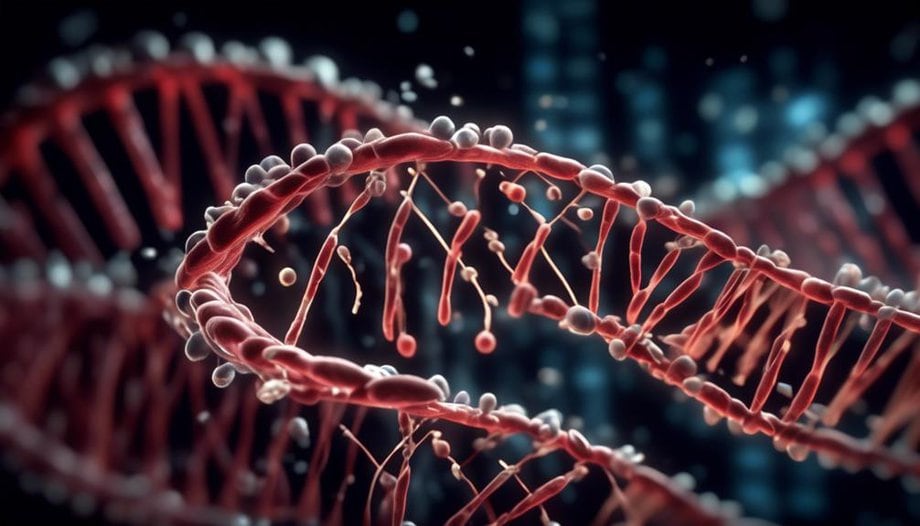Discovery of Circulating Tumor DNA (CtDNA) (1948) – Mandel & Metais: Recap and Summary: Found DNA From Tumors in the Blood

Circulating Tumor DNA (CtDNA) is DNA from tumors that can be found in the bloodstream. It was discovered by Mandel and Metais in 1948. This groundbreaking revelation has revolutionized cancer research, opening up new possibilities for cancer detection and treatment.
Key Takeaways
- Mandel & Metais discovered Circulating Tumor DNA (CtDNA) in 1948, challenging the belief that DNA was confined to the cell nucleus.
- CtDNA analysis enables early cancer detection and personalized treatment strategies.
- CtDNA serves as a biomarker for cancer, allowing assessment of tumor presence and progression.
- CtDNA analysis reduces the need for invasive procedures like biopsies, making it more convenient and less risky for patients.
Background of Mandel & Metais
The background of Mandel & Metais provides valuable insights into the pioneering research and significant contributions made in the field of circulating tumor DNA (CtDNA) detection and analysis. In the historical context, Mandel & Metais were the first to discover the presence of tumor-derived DNA in the blood. Their groundbreaking work in 1948 laid the foundation for the development of non-invasive methods for cancer diagnosis and monitoring.
At the time, the prevailing belief was that DNA was confined within the cell nucleus and not present in the bloodstream. However, Mandel & Metais challenged this notion by demonstrating the existence of circulating tumor DNA in the blood of cancer patients. Their discovery revolutionized the field of oncology by introducing the concept that tumor DNA could be detected and analyzed through a simple blood test.
Mandel & Metais' contributions paved the way for further advancements in the detection and analysis of CtDNA. Their work opened up new possibilities for early cancer detection, monitoring treatment response, and identifying resistance mutations.
Today, CtDNA analysis is widely used in clinical practice and research, enabling personalized medicine approaches and improving patient outcomes.
Significance of the 1948 Discovery
The pioneering discovery of circulating tumor DNA (CtDNA) by Mandel & Metais in 1948 revolutionized the field of oncology and laid the groundwork for non-invasive methods in cancer diagnosis and monitoring. This breakthrough has had a significant impact on early detection and potential applications in the field of cancer research.
The significance of early detection can't be overstated. Identifying cancer at an early stage greatly increases the chances of successful treatment and improved patient outcomes. CtDNA allows for the detection of tumor-specific genetic alterations, even before the tumor becomes clinically evident. This provides an opportunity for early intervention and personalized treatment strategies tailored to the individual patient.
The potential applications of CtDNA are far-reaching. It can be used to monitor treatment response and detect minimal residual disease, allowing for timely adjustments in therapy. Additionally, CtDNA analysis holds promise in the field of liquid biopsies, where a simple blood test can provide valuable information about tumor genetics and guide treatment decisions.
Furthermore, by capturing the heterogeneity of tumors, CtDNA analysis can potentially aid in the development of targeted therapies and the identification of drug resistance mechanisms.
Methodology Used by Mandel & Metais
To understand the methodology used by Mandel & Metais in their discovery of circulating tumor DNA (ctDNA), you need to focus on three key points.
First, their DNA extraction technique was crucial in isolating ctDNA from the blood samples obtained.
Second, the collection of blood samples was carefully conducted, ensuring the preservation of ctDNA and minimizing contamination.
Lastly, the researchers targeted tumor-specific genetic mutations, allowing for the detection and analysis of ctDNA that originated from the tumor.
These three points highlight the scientific approach and precision employed by Mandel & Metais in their groundbreaking study.
DNA Extraction Technique
Using a standardized protocol, Mandel and Metais employed a DNA extraction technique to isolate Circulating Tumor DNA (CtDNA) from blood samples. This technique involved several steps to ensure the extraction of high-quality DNA for subsequent analysis.
The DNA extraction method used by Mandel and Metais was based on phenol-chloroform extraction, a widely used technique at the time. This method involved the use of organic solvents to separate DNA from other cellular components.
To quantify the CtDNA extracted from the blood samples, Mandel and Metais utilized a spectrophotometer, which measures the absorbance of DNA at a specific wavelength. By comparing the absorbance readings with a standard curve, they were able to determine the concentration of CtDNA in the samples.
Blood Sample Collection
After successfully extracting high-quality DNA using the phenol-chloroform extraction method, Mandel and Metais proceeded to collect blood samples for their study on Circulating Tumor DNA (CtDNA). Blood sample analysis plays a crucial role in liquid biopsy applications, allowing researchers to detect and monitor tumor-specific genetic alterations non-invasively. Mandel and Metais employed a standard blood collection procedure to obtain the samples needed for their study. The procedure involved drawing blood from patients into tubes containing an anticoagulant, such as EDTA or heparin, to prevent clotting. The collected blood samples were then processed to separate the plasma or serum from the cellular components. This separation is essential as it allows for the isolation and analysis of ctDNA, which is derived from tumor cells and released into the bloodstream. Table 1 provides a summary of the blood collection procedure used by Mandel and Metais.
| Step | Procedure |
|---|---|
| 1 | Draw blood from patients into tubes containing anticoagulant. |
| 2 | Process the blood samples to separate plasma or serum from cellular components. |
| 3 | Isolate ctDNA from the plasma or serum for analysis. |
Table 1: Blood collection procedure used by Mandel and Metais for ctDNA analysis.
The successful collection of blood samples is a critical step in the study of ctDNA and its potential applications in liquid biopsy. By following a standardized procedure, researchers can ensure the integrity and quality of the samples, enabling accurate analysis and interpretation of the genetic alterations present in ctDNA.
Tumor-Specific Genetic Mutations
Mandel and Metais implemented a robust methodology to identify tumor-specific genetic mutations in their study on Circulating Tumor DNA (CtDNA). By examining the DNA extracted from blood samples, they were able to identify specific genetic alterations that are unique to tumors. This breakthrough technique, known as liquid biopsy, offers a non-invasive alternative to traditional tissue biopsies for detecting and monitoring cancer.
Here are three key aspects of their methodology:
- Utilizing tumor biomarkers: Mandel and Metais focused on specific genetic markers, known as tumor biomarkers, that are indicative of the presence of cancer. These biomarkers serve as a guide for identifying tumor-specific mutations in the circulating DNA.
- Analyzing ctDNA: The researchers isolated ctDNA from the blood samples and performed genetic analysis to identify any mutations present. This allowed them to detect the presence of tumor-specific genetic alterations.
- Comparing with healthy DNA: To ensure the accuracy of their findings, Mandel and Metais compared the ctDNA with DNA from healthy cells. This comparison enabled them to distinguish between genetic mutations specific to the tumor and those occurring in healthy cells.
The methodology employed by Mandel and Metais paved the way for the development of liquid biopsies as a valuable tool in cancer diagnosis and monitoring.
Key Findings of the Study
The study revealed significant and noteworthy key findings regarding the discovery of Circulating Tumor DNA (CtDNA).
One of the key findings was the identification of tumor-specific genetic mutations in the ctDNA. This discovery is of great significance as it provides a non-invasive method for detecting and monitoring tumor progression. By analyzing the ctDNA, researchers can identify specific genetic alterations that are present in the tumor cells. This allows for a more targeted approach to cancer treatment, as therapies can be tailored based on the specific mutations present in the ctDNA.
Another key finding of the study was the detection of ctDNA in the blood of cancer patients. This finding is significant because it suggests that ctDNA can be used as a biomarker for cancer. By measuring the levels of ctDNA in the blood, healthcare professionals can assess the presence and progression of tumors. This non-invasive method reduces the need for invasive procedures such as biopsies, making it more convenient and less risky for patients.
Impact of CtDNA on Cancer Research
CtDNA has had a significant impact on cancer research by revolutionizing the way tumors are detected and monitored. Its application in early cancer detection has provided a breakthrough in the field, offering a non-invasive method for identifying tumors at an early stage. By analyzing ctDNA in the bloodstream, researchers can identify specific genetic alterations that are indicative of tumor presence. This enables the detection of cancer even before symptoms appear, allowing for earlier intervention and improved patient outcomes.
Furthermore, ctDNA has proven to be a valuable tool in monitoring treatment response. By regularly analyzing ctDNA levels during treatment, researchers can assess the effectiveness of therapies and make informed decisions regarding treatment adjustments. This real-time monitoring allows for personalized medicine approaches, tailoring treatment plans to individual patients, and maximizing the chances of success.
The impact of ctDNA on cancer research can be summarized as follows:
- CtDNA enables early cancer detection, allowing for intervention at the earliest stages of the disease.
- It provides a non-invasive method for monitoring treatment response, enabling personalized treatment plans.
- The analysis of ctDNA provides valuable insights into tumor genetics, aiding in the development of targeted therapies.
Advancements in Cancer Detection With Ctdna
With its ability to detect tumors at early stages and monitor treatment response, the discovery of circulating tumor DNA (ctDNA) has paved the way for advancements in cancer detection. CtDNA analysis has revolutionized the field of personalized cancer treatment by providing a non-invasive method to identify specific genetic alterations in tumors.
Advancements in ctDNA detection techniques have allowed for increased sensitivity and accuracy in cancer diagnosis. The development of next-generation sequencing technologies has enabled the identification of low-frequency mutations in ctDNA, which can provide valuable information about tumor heterogeneity and evolution. This has significant implications for treatment decisions, as personalized therapies can be tailored to target specific genetic alterations.
In addition to early detection, ctDNA analysis also plays a crucial role in monitoring treatment response. By tracking changes in ctDNA levels during therapy, clinicians can assess the effectiveness of treatment and make timely adjustments if necessary. This real-time monitoring allows for a more dynamic approach to cancer management, optimizing patient outcomes and minimizing unnecessary interventions.
Furthermore, ctDNA analysis holds promise for the detection of minimal residual disease (MRD) and the early detection of recurrence. By monitoring ctDNA levels after surgery or other treatments, clinicians can identify the presence of residual tumor cells that may not be detectable by conventional imaging methods. This allows for early intervention and potentially improves overall survival rates.
CtDNA's Role in Personalized Cancer Treatment
Advancements in personalized cancer treatment have been made possible through the role of ctDNA analysis. ctDNA, or circulating tumor DNA, has emerged as a valuable tool in precision medicine, revolutionizing the way cancer is diagnosed and treated.
Here are three key ways in which ctDNA plays a pivotal role in personalized cancer treatment:
- Early detection: ctDNA acts as a non-invasive biomarker, allowing for the detection of tumor-specific genetic alterations in the blood. This enables the identification of cancer at its earliest stages, even before symptoms manifest. Early detection significantly improves treatment outcomes and patient survival rates.
- Treatment monitoring: ctDNA analysis provides real-time information on tumor dynamics and response to treatment. By monitoring changes in ctDNA levels and genetic alterations, clinicians can quickly assess the effectiveness of therapy and make personalized treatment adjustments accordingly. This allows for more precise and targeted interventions, minimizing unnecessary side effects and maximizing therapeutic benefits.
- Resistance detection: ctDNA analysis is also invaluable in identifying acquired resistance mechanisms in tumors. As cancer cells evolve and develop resistance to treatment, ctDNA can detect the emergence of new genetic alterations, enabling timely adjustments to treatment strategies. By identifying resistance early on, clinicians can explore alternative therapeutic options and improve patient outcomes.
Future Directions for CtDNA Research
Future directions for research on circulating tumor DNA (ctDNA) encompass exploring novel applications and technologies to further enhance its diagnostic and therapeutic potential in the field of cancer management. While ctDNA has shown promise in personalized cancer treatment, there are still potential limitations that need to be addressed.
One future application of ctDNA research is the early detection of cancer. By developing more sensitive and specific ctDNA detection methods, it may be possible to identify cancer at an earlier stage when treatment is more likely to be effective. This could significantly improve patient outcomes and survival rates.
Another potential application is monitoring treatment response and detecting minimal residual disease. By analyzing ctDNA levels and genetic alterations during and after treatment, clinicians can assess the effectiveness of therapy and identify any remaining tumor cells that may lead to relapse. This would allow for timely intervention and adjustment of treatment strategies.
Additionally, ctDNA research holds promise in predicting treatment response and guiding therapy selection. By analyzing the genetic mutations and alterations present in ctDNA, clinicians can tailor treatment plans to target specific molecular characteristics of the tumor. This personalized approach could improve treatment outcomes and minimize unnecessary side effects.
However, there are certain limitations that need to be overcome for the future success of ctDNA research. These include the need for standardized protocols, improved sensitivity and specificity of ctDNA detection methods, and the development of robust bioinformatics tools for data analysis and interpretation.
Frequently Asked Questions
How Has the Discovery of Circulating Tumor DNA (CtDNA) Impacted Current Cancer Treatments?
The discovery of circulating tumor DNA (ctDNA) has revolutionized cancer treatments. Its impact on precision medicine and role in early detection have brought newfound hope and possibilities to the fight against cancer.
What Are Some Potential Future Applications for Ctdna Research?
In the future, potential applications and advancements in circulating tumor DNA (ctDNA) research could revolutionize cancer diagnosis, monitoring treatment response, detecting minimal residual disease, and developing personalized therapies.
Are There Any Limitations or Challenges Associated With Detecting Ctdna in the Blood?
Detecting ctDNA in the blood poses limitations and challenges. Factors such as low abundance, genetic heterogeneity, and technical limitations can affect its detection. Overcoming these obstacles is crucial for the advancement of ctDNA research.
How Does the Presence of Ctdna in the Blood Correlate With Tumor Progression and Response to Treatment?
The presence of ctDNA in the blood has been observed to correlate with tumor progression and response to treatment. It serves as a biomarker for treatment response and can also provide insights into tumor size.
How Has the Study of Ctdna Changed Our Understanding of Cancer Biology and the Development of Personalized Cancer Therapies?
The study of ctDNA has revolutionized our understanding of cancer biology and personalized cancer therapies. Its impact on personalized medicine and role in early detection have given individuals the freedom to make informed decisions about their treatment.








